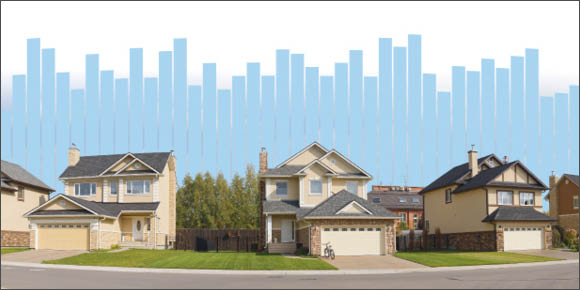What are the latest trends among buyers and sellers? Top of the list: millennials are moving, and it’s not to the city centers …
By Daniel Rome Levine
While the overall number of first-time homebuyers continues to decline, one segment of the population is bucking the trend. Young people ranging in age from their late teens to mid-30s, known as millennials, are the largest and fastest growing group of homebuyers, according to the National Association of REALTORS® (NAR). Instead of converted industrial spaces and hip coffee shops in city centers, these young people are opting instead for older single-family homes with manicured lawns and soccer leagues in the suburbs.
The median age of millennials, 30, is the driving force behind this trend. “This is typically the time in life where one settles down to marry and raise a family,” says Lawrence Yun, NAR’s chief economist. And these buyers are choosing the suburbs over the city, he adds, because of a shortage of condos in urban centers fitting their entry-level price range. “Affordability pressures make buying in the city extremely difficult for most young households,” he says. “Even if an urban setting is where they’d like to buy their first home, the need for more space at an affordable price is for the most part pushing their search further out.”
Millenial Market
Being knowledgeable about trends that are shaping the decisions of homebuyers and sellers offers unique insight into what is driving these people and can give you an edge in gaining their business and trust. Knowing what types of homes and in what areas people in different age groups are gravitating toward, for instance, can make you a more valuable and an indispensable adviser to clients. To find out about the latest trends among buyers and sellers, The Residential Specialist examined numerous surveys, reports and other data and spoke to REALTORS® to learn what they are seeing.
While millennials are having a big impact on the market now, their influence will grow even more dramatically in coming years, according to experts. A report by Goldman Sachs, “Millennials: Coming of Age,” points out that at 92 million young people strong, millennials represent the largest generation in history, even bigger than baby boomers. And while many of them are choosing to live at home longer with their parents, they clearly yearn to leave the nest one day. The report points out that a whopping 93 percent of millennial renters surveyed say they want to own a home at some point down the road. When they do? “Their sheer size … could lead to a surge in homes sales,” concludes the report.
One Big, Happy Family
At the other end of the demographic spectrum, the percentage of people buying senior-related housing, as tracked by the NAR’s annual Profile of Home Buyers and Sellers survey, increased to 14 percent in 2015, up from 11 percent in 2010 when this segment of the population was first tracked for the report. And children of older parents were also looking after mom and dad and wanting to keep them closer to their families. The same survey found that 13 percent of homebuyers purchased a home that could be shared by multiple generations so they could take care of aging parents and children over 18 who are moving back home.
The “Missing Link”
One of the more alarming trends uncovered in the NAR survey is the continuing and persistent decline in first-time homebuyers. Yun calls it “the housing recovery’s missing link.” At 32 percent of all buyers in 2015, this is the lowest number of first-time buyers since 1987 when it stood at 30 percent, and the second-lowest share since the survey was first taken in 1981.
Historically, first-time buyers should represent about 40 percent of the overall buyer pie, according to NAR. With record-low interest rates, an improving economy and increasing rents, one would think the landscape would be ideal for first-time buyers. But Yun points out there are significant obstacles hindering them. Among them, those same high rents cut into the amount they can save for a down payment. Also, home prices are rising in many markets because of high demand coupled with tight inventory. Across the U.S., the number of homes for sale is 9 percent lower than it was in 2015, and in 31 of the 34 largest markets, there are fewer homes for sale than last year, according to Zillow.
It is also still proving tough for some to get a mortgage. Many potential first-time buyers also report being saddled with high levels of debt that make it difficult to save for a down payment.
Smaller Is Better
Married couples who have an average annual household income of $108,600 represent the biggest share of buyers, 67 percent, in the NAR survey. Amy Kite, CRS, with Keller Williams Realty Infinity, has been helping many clients just like these buy and sell houses throughout the greater Chicago area for nearly a decade. The biggest trend she is observing? Smaller is better.
“People are absolutely buying smaller houses today,” she says of the trend she first noticed about a year and a half ago. “They want something that is more manageable, and easier to clean and take care of. They don’t want to be a slave to their house and the land, and everything else that comes with a big property.”
Earlier this year, she worked with a couple who had three children, ranging in age from 7 to 15. The family had spent 10 years in their 4,000-square-foot home, and even though they still had a house full of kids, they were ready to downsize. Kite found them a 2,800-square-foot home in the same school district with property taxes 40 percent lower than what they had been paying.
“They just wanted to be able to enjoy life a little more and they found that all the money was going into the house,” says Kite. “With their smaller home, they can expect to have another vacation or two every year.”
Kite’s awareness of the trend of buyers seeking smaller homes enabled her to serve her clients faster and get a quick jump on finding them just the right property. Being knowledgeable and up to date on market trends will enable you to serve your clients more effectively, and that will not only give you an edge over competitors, but it will make you an indispensable partner for buyers and sellers in your market.








